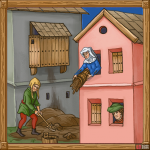Text
It’s well known that medieval Europe was not particularly hygienic. Most household waste ended up just a few meters from the house. There wasn’t as much waste as today, and most of it (if not all) was organic in nature. People were frugal and true masters at using everything down to the last piece.
Food preparation scraps were minimal, and the same was true for processing animal products. Old clothes were remade, old dishes repaired, and furniture lasted for generations. Consequently, the most waste produced by people came from their own digestion. This waste ended up, at best, in compost, which over time became good, quality soil (though the compost heap itself was right behind the house), or in a cesspit, and at worst, in the river or on the street, where it contributed to the iconic mud.
Since wells were directly beneath urban houses, or water was taken from the river for drinking, epidemics of typhoid, cholera, and hepatitis were common.
Other waste, which we haven’t yet mentioned, ended up just outside the city walls or, in the case of villages or artisanal production, behind the nearest embankment. Not infrequently, the ditches along the walls were more like bottomless rubbish dumps.


No Comments